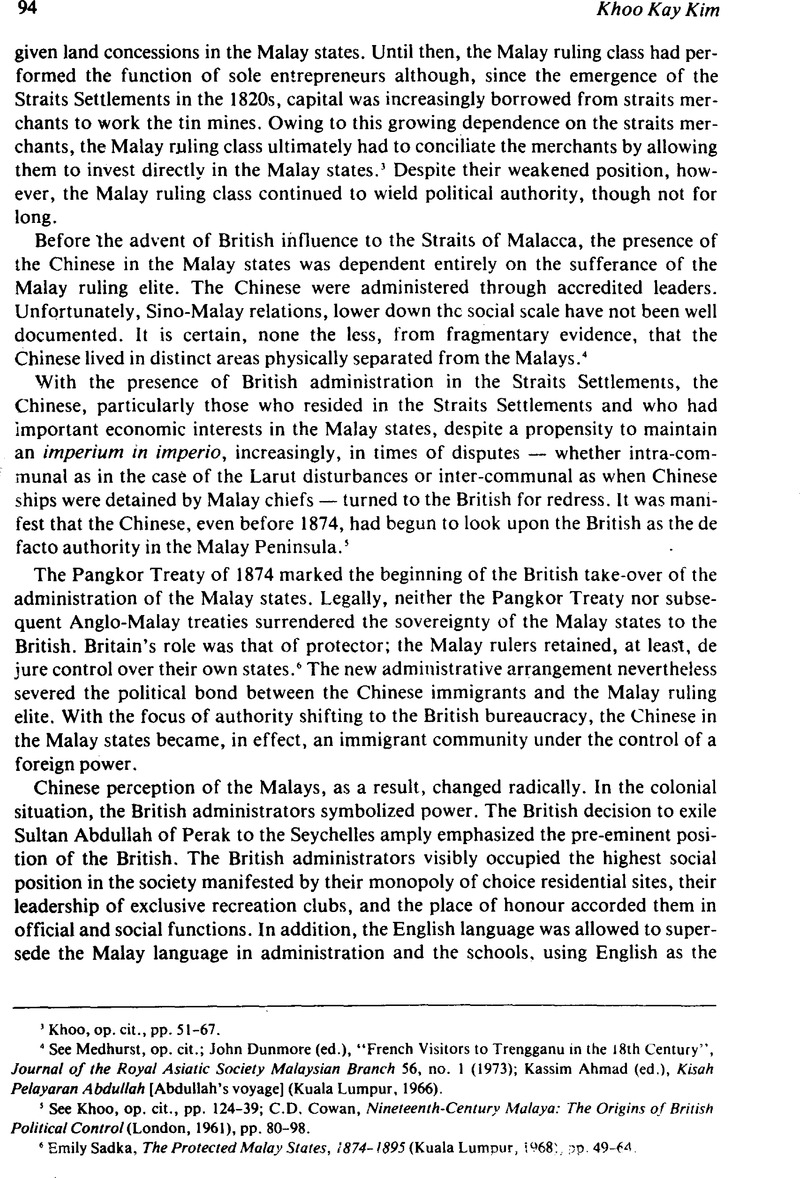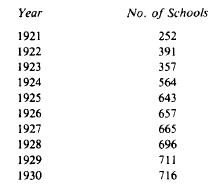Published online by Cambridge University Press: 24 August 2009

3 Khoo, op. cit., pp. 51–67.
4 See Medhurst, op. cit.; Dunmore, John (ed.), “French Visitors to Trengganu in the 18th Century”, Journal of the Royal Asiatic Society Malaysian Branch 56, no. 1 (1973)Google Scholar; Ahmad, Kassim (ed.), Kisah Pelayaran Abdullah [Abdullah's voyage] (Kuala Lumpur, 1966)Google Scholar.
5 See Khoo, op. cit., pp. 124–39; Cowan, C.D., Nineteenth-Century Malaya: The Origins of British Political Control (London, 1961), pp. 80–98Google Scholar.
6 Sadka, Emily, The Protected Malay States, 1874–1895 (Kuala Lumpur, 1968): pp. 49–64Google Scholar.
7 Siang, Song Ong, One Hundred Years' History of the Chinese in Singapore (London, 1923)Google Scholar. Some of the Chinese who studied in the United Kingdom were Lim Boon Keng, Song Ong Siang, S.C. Yin, P.V.S. Locke, Wu Lien Teh, Wee Theam Tew, and Goh Lai Nee.
8 Tan Cheng Lock, in the Straits Legislative Council, on 14 Apr. 1924, said: “The door to the highest sphere of human activity, an active and real participation in the Government and administration of their country, is banged, barred and bolted to them…. We feel that our position at present is that of ‘hewers of wood and drawers of water’. Is it therefore surprising that such highly capable and ambitious men of the type of Dr. Lim Boon Keng and Dr. Wu Lien Teh who are British subjects and who love this country should have left to give their services in China … ? ” (Cited by Tregonning, K.G., “Tan Cheng Lock: A Malayan Nationalist”, Journal of Southeast Asian Studies 10, no. 1 (1979):29CrossRefGoogle Scholar.
9 See Seng, Png Poh, “The Kuomintang in Malaya”, Journal of Southeast Asian History 2, no. 1 (1961)Google Scholar.
10 One of the very first steps taken by the British upon establishing a Western-type administration in every Malay state was to deprive the traditional ruling class of the authority entrusted to it previously. Below the Resident, British Collectors of Revenue were appointed in each major district — their authority superseded that of the traditional territorial chief.
11 Punitive expeditions were sent to Perak and Sungai Ujong in 1875, Pahang in the early 1890s, Kelantan in 1915, and Trengganu in 1928.
12 See Roff, William R., The Origins of Malay Nationalism (Kuala Lumpur, 1967), pp. 54–55Google Scholar.
13 See Matton, Abdul Aziz b., “Al-lmam Sepintas Lalu” [Al-lmam at a glance], Jernal Sejarah [Journal of the Historical Society, University of Malaya, Kuala Lumpur] 11 (1972/1973)Google Scholar; Abdullah, bin Jaafar, Haji, “Al-Imam”, in Lembaran Akhbar Melayu [The pages of Malay newspapers] (Kuala Lumpur, 1980)Google Scholar.
14 Most of the elaborate brick houses in the Straits Settlements were owned by the Chinese. In Malacca, after the Dutch had left, the very exclusive residential area — Heeren Street — came under the ownership of the Chinese. The English-educated Chinese, especially the professionals, were impeccably dressed (like Europeans). For photographs of Chinese mansions and dressing (Western-style), see Song, op. cit.; Wright, A. and Cartwright, H.A. (eds.), Twentieth-Century Impressions of British Malaya: Its History, People, Commerce, Industries and Resources (London, 1908)Google Scholar.
15 After Al-lmam ceased publication in 1908, the Kaum Muda continued their crusade through another journal — Neraca. See Mustajab, Mohd. Sarim Hj., “Neraca 1910-Jun 1915 Penyambung Nafas Islah Al-lmam” [Neraca 1910-June 1915 continuation of the reformist aspiration of Al-lmam], Jurnal Budaya Melayu [Journal of the Department of Malay Letters, Universiti Kebangsaan Malaysia] 3, no. 1 (1978)Google Scholar.
16 For a biography of Za'ba, see Nawang, Adnan Haji Mohd., “Za'ba 1896–1973: Satu Tinjauan tentang Kegiatan-kegiatannya” [Za'ba 1896–1973: a survey of his activities] (B.A. Hons. diss. University of Malaya, 1977/1978)Google Scholar. In the mid-fifties, Za'ba, at an advanced age, was the Acting Head of the Dept. of Malay Studies, University of Malaya, Singapore.
17 See Roff, William R., “The Origins and Early Years of the Majlis Agama”, in Roff, William R., Kelantan: Religion, Society and Politics in a Malay State (Kuala Lumpur, 1974)Google Scholar. See also Ahmad, Ramli Haji and Hassan, Che Zaharah Che, “Pengasuh”, in Lembaran Akhbar MelayuGoogle Scholar, op. cit.
18 Ramli and Zaharah, op. cit., pp. 46–50.
19 See Kim, Khoo Kay, “Perkembangan Pelajaran Agama Islam” [The development of Islamic education], in Pendidikan ke Arah Perpaduan: Sebuah Perspeklif Sejarah [Education for unity: a historical perspective] ed. Salleh, Awang Had (Kuala Lumpur, 1980)Google Scholar.
20 For details of the publication of Malay newspapers and journals during this period, see Roff, William R., Bibliography of Malay and Arabic Periodicals Published in the Straits Settlements and Peninsular Malay States, 1876–1941 (London, 1972)Google Scholar.
21 See Kim, Khoo Kay, “The Beginnings of Political Extremism in Malaya, 1915–1935” (Ph.D. diss., University of Malaya, 1973)Google Scholar.
22 Number of Chinese schools in the Federated Malay States and the Straits Settlements, 1921–30:

[Source: Yuet-hung, Mable Yung, “Contributions of the Chinese to Education in the Straits Settlements and the Federated Malay States, 1900–1941” (M.A. diss., University of Malaya, 1967), pp. 72–73.Google Scholar]
23 Tregonning, op. cit., pp. 29–33.
24 For a lengthy discussion of the subject, see Ghosh, Kalyan Kumar, Twentieth-Century Malaysia: Politics of Decentralization of Power, 1920–1929 (Calcutta, 1977)Google Scholar.
25 For some idea of the contents of Malay newspapers, see Lembaran Akhbar Melayu, op. cit.; see also bin Mahmud, Zulkipli, Warta Malaya Penyambung Lidah Bangsa Melayu, 1930–1941 [Warta Malaya prolocutor of the Malay race, 1930–1941] (Kuala Lumpur, 1979)Google Scholar; Adam, Ramlah, “Lembaga Malaya, 1934–1941”, Malaysia Dari Segi Sejarah [Journal of the Malaysian Historical Society], no. 8 (1979)Google Scholar.
26 See Ngah, Zabedah Awang (ed.), Antoloji Esei Melayu dalam Tahun2 1924–1941 [An anthology of Malay essays in the years 1924–1941] (Kuala Lumpur, 1964), pp. 129–30Google Scholar.
27 Pengasuh, 6 Nov. 1930. For a biography of Abdul Kadir Adabi, see Rahman, Abdul bin Al-Ahmadi, Haji Mohamad Daud, “Satu Kajian dan Perbandingan Riwayat Hidup Kadir Adabi denjjan Assad Shukri” [A comparative study of the lives of Kadir Adabi and Assad Shukri] (M.A. diss., University of Malaya, 1978)Google Scholar; see also Kim, Khoo Kay, “Malay Society, 1874–1920s”, Journal of Southeast Asian Studies 5, no. 2 (1974): 192–93CrossRefGoogle Scholar.
28 Emerson, R., Malaysia: A Study in Direct and Indirect Rule (Kuala Lumpur, 1964), p. 313Google Scholar.
29 Saudara, 9 May 1931.
30 Majlis, 18 07 1932Google Scholar.
31 Majlis, 13 10 1932Google Scholar.
32 Cited in Emerson, op. cit., p. 506.
33 Ibid., n. 7.
34 Vlieland, C. A., British Malaya: A Report on the 1931 Census, Table 1Google Scholar.
35 Straits Times, 23 12 1932Google Scholar.
36 Emerson, op. cit., p. 513, n. 10.
37 Rajeswary, Ambalavanar, “Aspects of Leadership of the Indian Community in Malaya in the period 1920–41” Tamil Oli [Journal of the University of Malaya Tamil Language Society], 1969/1970, pp. 88–89Google Scholar.
38 See Tan, Diana (Ooi), “The Penang Straits Chinese British Association”, Malaysia in History 21, no. 2 (1978):47Google Scholar.
39 Apart from Tan Cheng Lock, another outspoken leader of the Chinese peranakan was Lim Cheng Yan, a Penang lawyer.
40 Mohamad, bin Ismail, , “Suara Benar — Akhbar Melayu Terawal di Melaka” [Suara Benar — The earliest Malay newspaper in Melaka], Jernal Sejarah 11 (1972/1973):52Google Scholar.
41 Ibid. The arguments of the local-born Chinese, generally, in pressing for equal opportunities and rights might be summed up thus: (1) they were invited to the country, (2) they had sacrificed their lives in the country, (3) they had opened up, developed, and enriched the country, (4) they were a law-abiding race, (5) they were born and belonged here and they were of “Malayan” nationality, (6) they were loyal to Britain.
42 Malay newspapers from time to time reported the political activities of the Chinese. For example, the Warta Malaya of 8 July 1938 reported that in Batu Pahat on 7 July, which was a commemoration day for the Chinese, was widely observed by the Chinese who closed their shops. The market too was closed and bus companies did not provide service. The Chinese gathered in a theatre to listen to speeches. The same situation occurred in Seremban (Zulkipli, op. cit., p. 86, n. 48).
43 For a detailed study of Chinese political activities in the late thirties, see Leong, Stephen Mun Yoon, “Sources, Agencies and Manifestations of Overseas Chinese Nationalism in Malaya, 1937–1941” (Ph.D. diss., University of California, Los Angeles, 1976), pp. 249–792Google Scholar.
44 The first report was submitted to the Colonial Office on 5 Mar. 1931 (C.O. 273/81, File No. 82398).
45 Emerson, op. cit., p. 512.
46 Mohammad Ismail, op. cit., p. 53.
47 Ibid. It is interesting to note that in June 1933, the MCP posted leaflets to editors of vernacular newspapers which, among other things, commented on the Aliens Ordinance: “Moreover they call the Chinese and Indians aliens. In this way they entirely neglect the credit due to the Chinese and Indians for the development of Malaya. The British Government separates the Chinese and Indians from the Malays. Is not this ruining the unity of the races and arousing ill-feeling towards the Chinese and Indians?” (C.O. 273/585, File No. 13008/III, Monthly Review of Chinese Affairs, June 1933).
48 For a biography of Rahim Kajai, see Abu Bakar, Abdul Latiff, “Abdul Rahim Kajai”, in Sastera dan Sasterawan, [Literature and litterateur], ed. Kim, Khoo KaySastera dan Sasterawan, (Kuala Lumpur, 1980)Google Scholar.
49 For a comprehensive account of this association, see Osman, bin Hassan, , Berita Pergerakan Kesatuan Melayu Singapure, 1926–1937 [News on the Singapore Malay Union Movement, 1926–1937]Google Scholar. The writer was one of the active members of the association (and also the father of Prof Taib Osman of the University of Malaya).
50 In the colonial society of Singapore, the British often appointed Arabs or Indian Muslims as leaders of the Muslim community because they, rather than the Malays, were men of wealth and property.
51 Rahim Kajai had discussed the need to take steps to formalize Malay unity in various issues (in Apr.) of the Penang paper, Saudara, in 1930. In Dec. 1930, Kadir Adabi, in Kota Bharu, proposed the formation of a Peninsular Malay Union (see Pengasuh, 21 Dec. 1930).
52 Majlis, 12 01 1933Google Scholar.
53 Majlis, 29 07 1934Google Scholar.
54 Majlis, 6 02 1933Google Scholar.
55 Majlis, 12 01 1933Google Scholar.
56 Majlis, 31 12 1934Google Scholar.
57 Majlis, 2 11 1933Google Scholar.
58 Majlis, 1 05 1933Google Scholar.
59 See, e.g., Utusan Zaman, 23 Mar. 1940 and 31 Aug. 1940.
60 Majlis, 9 05 1932Google Scholar.
61 C O. 273/616, File No. 50147, Straits Settlements Police Special Branch Report 1935; see also Roff, , Origins of Malay Nationalism, pp. 212–21Google Scholar.
62 See Roff, William R., “The Persatuan Melayu Selangor: An Early Malay Political Association”, Journal of the Southeast Asian History 9 (03 1968)CrossRefGoogle Scholar. There are indications that, in the Peninsula, the Kelantanese formed the first political association. Known as Kelab Putera and believed to have existed in 1929, this was, however, a very small group and failed to survive because of pressure from the state government. There was also a Persekutuan Setiawan Belia organized by largely graduates of the Madrasah Muhammadiah, a school established in 1917, by the Religious Affairs Council. Members of the Kelab Putera were involved in the Setiawan Belia which, in the late thirties, also provided the base for the formation of the Ibrahim Yaacob-led Young Malays Union in Kelantan. The Setiawan Belia was founded on 1 Oct. 1931. On the eve of the Second World War, under the leadership of Tengku Mahmud bin Sultan Muhammad IV, an association known as the Persekutuan Persetiaan Melayu Kelantan was formed (9 Feb. 1940). This appears to have been the sequel to the attempt by another group to form a Persatuan Melayu Kelantan which failed to receive the sanction of the Kelantan government. [See Khoo Kay Kim, “Malay Society, 1874–1920s”, idem, “Islam and Politics in Kelantan” (review article), Journal of Southeast Asian Studies 11, no. 1 (1980): 192–94; Abdul Rahman, op. cit., p. 33.